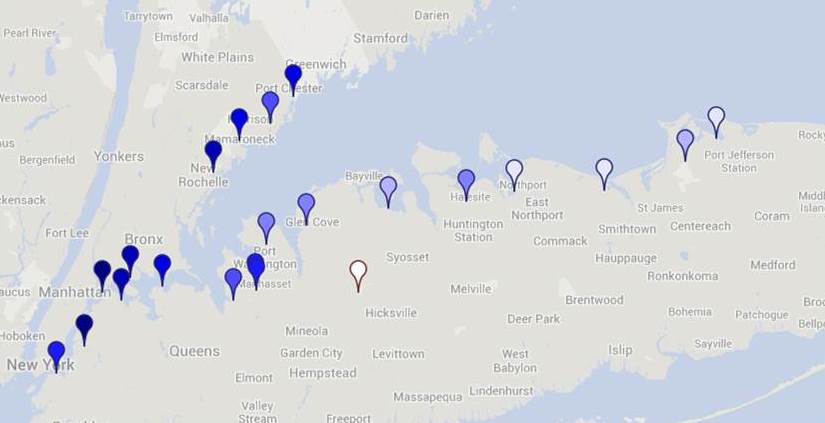Save the Sound Grades New York’s Sewage Treatment Plants
Plants Must Reduce Nitrogen to Long Island Sound by 2017 to Heal Dead Zone
FOR IMMEDIATE RELEASE
Monday, April 14, 2014
Contact:
Laura McMillan: 203-787-0646 x137
Tom Andersen:
MAMARONECK, NY — Save the Sound today released a report card and interactive map tracking upgrades at New York’s sewage treatment plants around Long Island Sound. As a federally mandated deadline approaches, overall the plants are successfully cutting pollution but upgrades at some of the most critical plants still need to be completed.

Nassau and Suffolk counties have completed their upgrades on time and received an A in Save the Sound’s report, “Healing the Sound’s Dead Zone: Are New York’s Sewage Treatment Plants Making the Grade?” Westchester County and New York City received a grade of B with a note that they are “at risk,” meaning that although they are on track, there is still much work to be completed before their 2017 deadline.
The nitrogen reduction projects are the result of a 2001 agreement between the U.S. Environmental Protection Agency, New York, and Connecticut. It requires New York and Connecticut to attain a 58.5 percent reduction in nitrogen discharges to Long Island Sound by 2014, although New York City and Westchester County subsequently were given an extension to 2017. Excess nitrogen is a primary cause of hypoxia, the low-oxygen condition that leads to a “dead zone” in the western Sound every summer that can stress and even suffocate marine life.
“This report card marks an important step in the generation-long effort to restore life-giving oxygen to the Sound and heal the dead zone, but we’re not there yet. To reclaim our heritage of great schools of fish, flocks of shorebirds and clear sparkling waters for all to enjoy, we must press on for a full recovery,” said Curt Johnson, executive director of Save the Sound. “We applaud Nassau and Suffolk Counties for completing their nitrogen upgrades on time. But we can’t get complacent. Westchester County and New York City still have work to do before 2017 and time is getting short. We have to make sure the plants stay on track until the work is done—there can be no senioritis here, no last-minute slacking off. The health of Long Island Sound is at stake.”
Connecticut has already attained its reductions, thanks in large part to the state’s Clean Water Fund, which assists municipalities with paying for sewer system and treatment plant upgrades. Save the Sound has advocated for New York state funding that would help coastal municipalities upgrade their treatment plants and repair badly-degraded sewer infrastructure that allows both nitrogen and bacteria into waterways, polluting the Sound and closing public beaches throughout the summer months.
With so much progress at treatment plants already, conditions in the Sound itself seem to have improved slightly. The dead zone is mostly confined to the section of the western Sound between Westchester and Nassau counties, although in August of 2012 seriously low levels of dissolved oxygen were measured as far east as New Haven, Ct., and Wading River, L.I. During that period, more than 20 percent of the Sound’s 1,300 square miles suffered from hypoxia. Long Island Sound’s ecology is complex, and scientists believe the full benefits of nitrogen reduction will emerge gradually.
The bulk of nitrogen reductions come from sewage treatment plants along the Sound, but there are other significant sources as well. Nitrogen from plants in Massachusetts and even further north is carried to the Sound via the Connecticut River. Other sources include stormwater runoff that carries pet waste and fertilizer from yards, and agricultural runoff. Tackling this type of pollution requires educating the public and farmers about ways to reduce fertilizer use, and increasing the use of green infrastructure like rain gardens that can trap and filter runoff before it reaches waterways.
“Restoring Long Island Sound to health is a long term project. It will require ongoing commitment from state lawmakers, local leaders, and the region’s residents to make the investments needed to improve our infrastructure and return the Sound to vitality,” Johnson said.
###
About Save the Sound
Save the Sound was originally founded in 1972 as the Long Island Sound Taskforce. Using legal expertise, grassroots advocacy, volunteer work, and habitat restoration, Save the Sound has successfully fought to preserve great coastal and island sites; fought for clean water; restored rivers and marshes; and cleaned up hundreds of miles of coastline in order to preserve and protect the Sound now and for future generations.
In 2004, Save the Sound merged with Connecticut Fund for the Environment and continues to advocate against threats to the natural environment in both New York and Connecticut and Long Island Sound.

3 thoughts on “Press Release: Save the Sound Grades NY Sewage Treatment Plants”
Comments are closed.